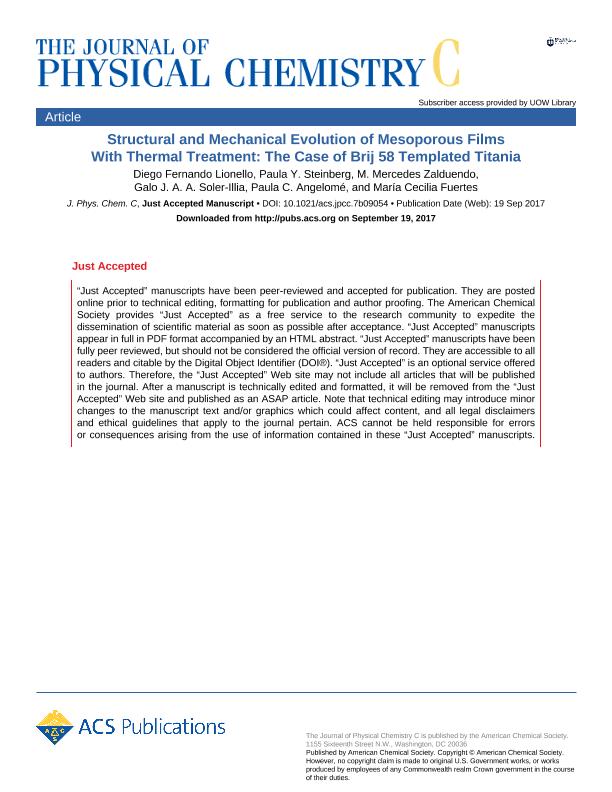Mostrar el registro sencillo del ítem
dc.contributor.author
Lionello, Diego Fernando

dc.contributor.author
Steinberg, Paula Yael

dc.contributor.author
Zalduendo, María Mercedes

dc.contributor.author
Soler Illia, Galo Juan de Avila Arturo

dc.contributor.author
Angelome, Paula Cecilia

dc.contributor.author
Fuertes, María Cecilia

dc.date.available
2018-04-06T16:48:00Z
dc.date.issued
2017-09
dc.identifier.citation
Lionello, Diego Fernando; Steinberg, Paula Yael; Zalduendo, María Mercedes; Soler Illia, Galo Juan de Avila Arturo; Angelome, Paula Cecilia; et al.; Structural and Mechanical Evolution of Mesoporous Films With Thermal Treatment: The Case of Brij 58 Templated Titania; American Chemical Society; Journal of Physical Chemistry C; 121; 40; 9-2017; 22576-22586
dc.identifier.issn
1932-7447
dc.identifier.uri
http://hdl.handle.net/11336/41124
dc.description.abstract
Mesoporous titania thin films (MTTFs) with well ordered cubic array of mesopores were synthesized on glass and silicon substrates using Brij 58 as a template. The effect of the thermal treatment and the substrate on the structural parameters (thickness, porosity, pore order, and crystallinity) and the mechanical properties of MTTFs were determined by electron microscopy, X-ray diffraction, Raman spectroscopy, 2D-small angle X-ray scattering, ellipsometric porosimetry, and nanoindentation. Clear differences in the mesostructural order evolution and crystallization behavior were observed as a function of the substrate and the thermal treatment. In particular, the anatase crystallization process occurs at lower temperatures for samples prepared on silicon when compared with samples prepared on glass, due to the balance between nanocrystals formation, mass diffusion, and Na+ migration from the substrate. As a consequence of such phenomena, the MTTFs mechanical properties are also dependent on the substrate. For samples prepared on glass the 325–350 °C range is the optimal annealing temperature to maximize the mechanical properties (E value of 45 GPa), while higher temperatures can be used for the Si supported oxides, to reach E values of 60 GPa. The obtained anatase crystal dimensions (below 4–5 nm) are restricted by the wall thickness, indicating the chosen thermal treatment prevents the mesoporous structure from collapsing even when the oxide presents thin walls and small pores, preserving high porosity and high porous ordering. As a consequence, the presented Brij 58 templated MTTFs exhibits smaller crystalline domains than analogous materials with thicker walls. Such properties could be exploited for applications in photocatalysis and titania-based solar cells.
dc.format
application/pdf
dc.language.iso
eng
dc.publisher
American Chemical Society

dc.rights
info:eu-repo/semantics/embargoedAccess
dc.rights.uri
https://creativecommons.org/licenses/by-nc-sa/2.5/ar/
dc.subject
Mesoporous Materials
dc.subject
Mechanical Properties
dc.subject
Nanoindentation
dc.subject.classification
Recubrimientos y Películas

dc.subject.classification
Ingeniería de los Materiales

dc.subject.classification
INGENIERÍAS Y TECNOLOGÍAS

dc.subject.classification
Nano-materiales

dc.subject.classification
Nanotecnología

dc.subject.classification
INGENIERÍAS Y TECNOLOGÍAS

dc.title
Structural and Mechanical Evolution of Mesoporous Films With Thermal Treatment: The Case of Brij 58 Templated Titania
dc.type
info:eu-repo/semantics/article
dc.type
info:ar-repo/semantics/artículo
dc.type
info:eu-repo/semantics/publishedVersion
dc.date.updated
2018-04-06T13:43:45Z
dc.journal.volume
121
dc.journal.number
40
dc.journal.pagination
22576-22586
dc.journal.pais
Estados Unidos

dc.description.fil
Fil: Lionello, Diego Fernando. Comisión Nacional de Energía Atómica. Centro Atómico Constituyentes; Argentina. Universidad Nacional de San Martín. Instituto Sabato; Argentina. Consejo Nacional de Investigaciones Científicas y Técnicas; Argentina
dc.description.fil
Fil: Steinberg, Paula Yael. Comisión Nacional de Energía Atómica. Centro Atómico Constituyentes; Argentina. Universidad de Buenos Aires. Facultad de Ciencias Exactas y Naturales. Departamento de Química Inorgánica, Analítica y Química Física; Argentina. Consejo Nacional de Investigaciones Científicas y Técnicas; Argentina
dc.description.fil
Fil: Zalduendo, María Mercedes. Comisión Nacional de Energía Atómica. Centro Atómico Constituyentes; Argentina. Universidad de Buenos Aires. Facultad de Ciencias Exactas y Naturales. Departamento de Química Inorgánica, Analítica y Química Física; Argentina. Consejo Nacional de Investigaciones Científicas y Técnicas; Argentina
dc.description.fil
Fil: Soler Illia, Galo Juan de Avila Arturo. Universidad Nacional de San Martin. Instituto de Nanosistemas; Argentina. Consejo Nacional de Investigaciones Científicas y Técnicas; Argentina
dc.description.fil
Fil: Angelome, Paula Cecilia. Comisión Nacional de Energía Atómica. Centro Atómico Constituyentes; Argentina. Consejo Nacional de Investigaciones Científicas y Técnicas; Argentina
dc.description.fil
Fil: Fuertes, María Cecilia. Comisión Nacional de Energía Atómica. Centro Atómico Constituyentes; Argentina. Universidad Nacional de San Martín. Instituto Sabato; Argentina. Consejo Nacional de Investigaciones Científicas y Técnicas; Argentina
dc.journal.title
Journal of Physical Chemistry C

dc.rights.embargoDate
2018-10-01
dc.relation.alternativeid
info:eu-repo/semantics/altIdentifier/doi/http://dx.doi.org/10.1021/acs.jpcc.7b09054
dc.relation.alternativeid
info:eu-repo/semantics/altIdentifier/url/https://pubs.acs.org/doi/10.1021/acs.jpcc.7b09054
Archivos asociados
